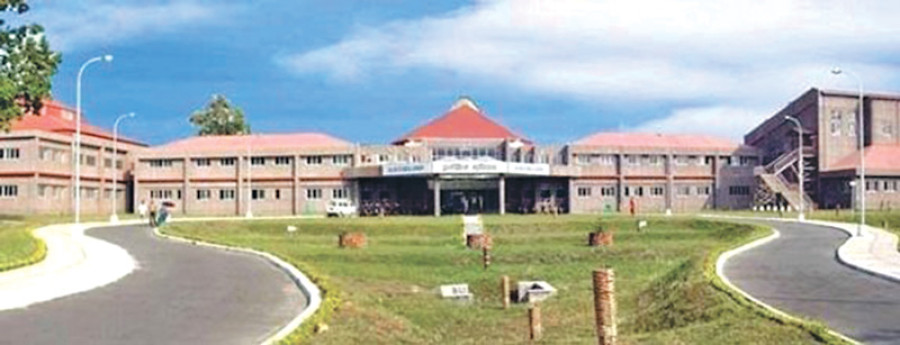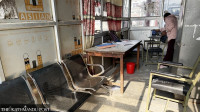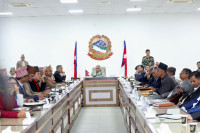National
Health Ministry set to run Post-Graduate programmes in big govt hospitals
Amid struggle to deploy and recruit specialist doctors to health facilities, the Ministry of Health (MoH) is preparing to start Post-Graduate (PG) programmes at government hospitals outside the Capital.
Manish Gautam
Amid struggle to deploy and recruit specialist doctors to health facilities, the Ministry of Health (MoH) is preparing to start Post-Graduate (PG) programmes at government hospitals outside the Capital.
Given the acute shortage MD/MS doctors outside Kathmandu, the ministry is mulling two modalities—either to affiliate all hospitals under the National Academy of Medical Sciences (NAMS) or form hospital clusters in each region to run the programme from June/July this year.
Under the first modality, the NAMS would recognise the government hospitals as teaching-learning centres allowing them to run the PG courses. Senior doctors of the hospitals will be appointed as professors and other required faculty members will be recognised before running the course as per criteria of the Nepal Medical Council—regulatory body for medical education in the country.
“Each student who wishes to be enrolled in the PG course will first have to sign a bond. This bond would state that the doctor will be automatically deployed to certain districts after completing their studies,” said Health Minister Gagan Thapa. “For instance, a doctor will have to sign a bond to work in Jajarkot hospital for five years before the beginning of the PG course.”
He said the admission in these hospitals would begin from this academic session and in next three years the government will have at least 300 PG doctors for deployment in health facilities at the grassroots level. “Only this way can we deploy the specialist doctors in entire health facilities,” he said.
Under the second modality, clusters will be formed in each region which will oversee the PG programmes. For instance, the BPKIHS based in Dharan will have to grant PG affiliation to government hospitals in the eastern region while allowing the NAMS to run additional programmes in the identified clusters. The Health Ministry has already formed a team under Dr Chop Lal Bhusal, former chairman of the Nepal Health Research Council, to figure out the clusters.
The team has so far identified five clusters. Mechi Zonal Hospital, Jhapa; Koshi Zonal Hospital, Morang and Sagarmatha Zonal Hospital, Saptari in the Eastern Region are clubbed in Cluster 1. Cluster 2 includes Bharatpur Hospital, Chitwan; Hetauda Hospital, Makwanpur and Narayani Sub Regional Hospital, Parsa. Cluster 3 has Pokhara Academy of Health Sciences, Kaski; Lumbini Zonal Hospital, Rupandehi and Tansen Hospital, Palpa. Cluster 4 includes Bheri Zonal Hospital, Banke; Midwestern Regional Hospital, Surkhet and Rapti Sub Regional Hospital, Dang. And Cluster 5 will have Mahakali Zonal Hospital, Kanchanpur and Seti Zonal Hospital.
“We plan to begin the PG course in at least one hospital of each cluster with around 50 students. This might change depending on detailed assessments we are currently working on,” said Dr Bhusal.
The deployment of specialist doctors is especially hard as government and private medical schools produce only a few specialist doctors each year.
There is disparity in the total PG seats available in the country—each year around 2,500 MBBS graduates are produced while only around 500 PG seats are available. While the undergraduate programmes in the medical field are making impressive strides in the country, the government’s inability to increase the PG seats has been a key contributing factor forcing many—who do not work with the government—to go abroad for specialised medical degrees.
As preparations are on to take in students from this year, the governmet is said to be focusing more on producing particular specialists including general physicians, anesthesiologist and orthopaedic surgeons.
Cluster 2: Bharatpur Hospital, Chitwan; Hetauda Hospital, Makwanpur and Narayani Sub Regional Hospital, Parsa.
Cluster 3: Pokhara Academy of Health Sciences, Kaski; Lumbini Zonal Hospital, Rupandehi and Tansen Hospital, Palpa.
Cluster 4: Bheri Zonal Hospital, Banke; Midwestern Regional Hospital, Surkhet and Rapti Sub Regional Hospital, Dang.
Cluster 5: Mahakali Zonal Hospital, Kanchanpur and Seti Zonal Hospital.




 14.12°C Kathmandu
14.12°C Kathmandu















